Fires ravaged not only plants and animals but the soils beneath them
The 2019-2020 Black Summer bushfires exposed critical top soil to erosion, stripping millions of tonnes from national parks alone, and placing at risk dozens of previously non-endangered plant and animal species.
The findings, contained in a NSW Planning Department report into the fires’ impact on the environment, estimate soil loss was the most in national parks and state forests, reducing the so-called ecological carrying capacity by more than a third in burnt areas.
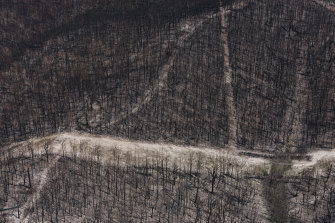
Bushland on the NSW South Coast, was among the hardest hit, with widespread soil loss following the bushfires.Credit:James Brickwood
Across the different land tenures, state forests were projected to have the biggest increase in erosion under average annual rainfall, rising 143 per cent, followed by national parks at 113 per cent. By comparison, privately held land burnt in the fires was expected to have a 45 per cent increase in soil loss, the report said.
“For absolute values, the highest average erosion rates were predicted in national parks, which reflects the more rugged terrain in those areas,†it said, with the North Coast and the South-east Corner bioregions the hardest hit.
Of the 5 million-plus hectares scorched during the state’s most extensive bushfires on record, about half were in national parks.
Using the modelled soil losses, soil erosion in the year after the fires under average rainfall would amount to 76.7 million tonnes, including 52.4 million tonnes in national parks and 13.9 million tonnes in state forests.
David Eldridge, an ecologist at the University of NSW’s Centre for Ecosystem Science, said studies of the effects on soil after bushfires point to huge erosion losses, particularly as heavy drought-breaking rains often follow big bushfire seasons.
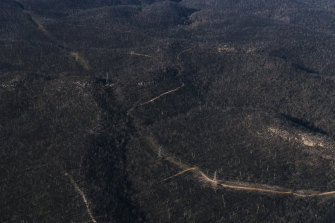
More than 80 per cent of the World Heritage-listed Greater Blue Mountains area, including much of the catchment atound Warragamba Dam.Credit:James Brickwood
A separate study showed the 2013 Warrambungle fire generated annual soil losses of about 25 tonnes per hectare, consistent with the government’s projected national park losses of 19.4 tonnes per hectare for national parks. Likewise, fires in the early 1980s in the Royal National Park resulted in yearly soil losses of 46 tonnes per hectare.
Professor Eldridge said erosion following fires had many adverse environmental effects, ranging from loss of soil carbon and nutrients such as nitrogen and phosphorus, to clogged waterways and reduced habitat.
“Soils take a long time to recover after fire because formation rates are extremely slow,†he said. “A typical rate for NSW is about one centimetre every thousand years. Repeated high-intensity fires will slow down this rate of soil formation.â€
A Planning Department spokeswoman said the combination of fire and follow-up rains could “trigger major erosion events as the capacity of landscapes to maintain soil stability changes as a result of the temporary loss of vegetation coverâ€.
“Erosion events can cover recovering plants and deplete seed banks in the soil,†she added.
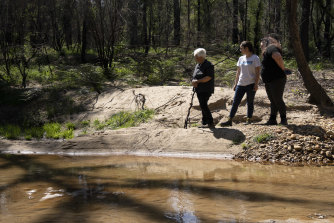
Traditional owners Kazan Brown, Taylor Clarke and Aunty Sharyn Halls at a water hole on the site.Credit:Wolter Peeters
The losses from erosion also extend to cultural heritage, such as in the Blue Mountains near Lake Burragorang.
A sacred water hole on Reedy Creek â€" believed by the Gundungurra traditional owners to be linked to Gurangatch, a Dreamtime spirit who was part fish and part reptile â€" was all but filled in by silt after the 2019-20 fires.
“We believe [Gurangatch] rested here,†Kazan Brown, a traditional owner, said. “It used to be about six-foot deep but now it’s only ankle deep.â€
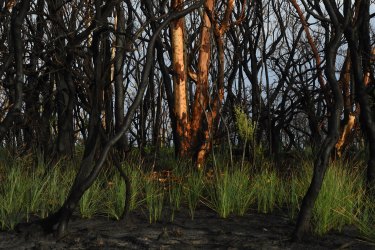
Fires ripped through Crowdy Bay National Park in November 2019.Credit:Kate Geraghty
The report noted that 123 plant species currently designated as non-threatened had more than 80 per cent of their recorded sightings in the 2019-20 fire ground, raising questions about whether their status should be changed. Similarly, 18 animal species now listed as non-threatened had more than half their recorded sightings in regions that were burnt.
“These numbers should ring serious alarm bells about the way NSW is able to manage threatened species,†Penny Sharpe, Labor’s environment spokeswoman, said. “To lose this much soil and to record so much environmental degradation puts at further risk our fragile threatened species.â€
Despite having such a report, the Berejiklian government cut spending on threatened species by a quarter in the budget released last month.
“Given the damage documented by the fires, there should be more money going into programs like Saving Our Species, not less,†Ms Sharpe said.
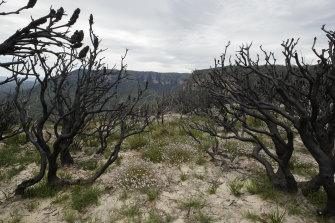
Pink flannel flowers amid burnt trees near the Golden Stairs lookout in the Blue Mountains.Credit:Brook Mitchell/Getty
The Morning Edition newsletter is our guide to the day’s most important and interesting stories, analysis and insights. Sign up here.
Peter Hannam writes on environment issues for The Sydney Morning Herald and The Age.

0 Response to "Fires ravaged not only plants and animals but the soils beneath them"
Post a Comment